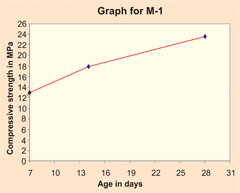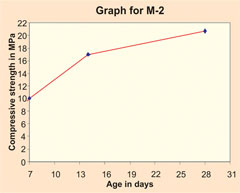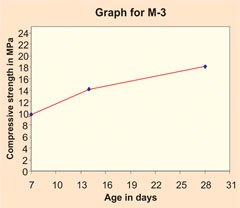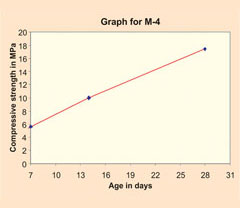N.S.Naik, Asst.Prof., Civil Engg. Dept. SRES C.O.E. Kopargaon,
U.P. Naik, Professor, Civil Engg.Dept. PREC Loni, Tal.Rahata, Dist. Ahmed Nagar and
M.S.Purkar, Professor., Civil Engg. Dept. SRES C.O.E. Kopargaon.
In Civil Engineering traditionally, we are using different materials in the form of building units. Some of the building units which we are using for construction are bricks and concrete blocks. Especially for bricks we have to use good plastic clay as primary raw material. This clay is often obtained from prime agricultural land, causing degradation as well as economic loss due to diversion of agricultural land. Manufacturing of bricks produces harmful gases which results in significant air pollution.
This feasibility study is an attempt to use cement, flyash and waste gypsum for the manufacturing of building units so as to replace the traditional building material at least partially.
Introduction
Traditionally, we are using burnt clay bricks for construction. It is a clay product which proved its importance since the dawn of civilization. For production of bricks, we are using good plastic clay as primary raw material. This clay is often obtained from prime agricultural land, causing land degradation as well as economic loss due to diversion of agricultural land. Though clay is easily and abundantly available in nature, its resources has a threshold limit and utilization of clay has reached such a point in construction. Excess use of good clay caused erosion of fertile soil and soil degradation and disturbed the ecology.
The burnt clay brick industry in India produces over 60 billion clay bricks annually resulting in strong impact on soil erosion and unprocessed emissions. For production of these bricks about 160 million tones of top soil, making barren 7500 acres of fertile land. (1) Because of all these ill effects, this is proper time to search an alternative of the burnt clay bricks.
Use of Cement, Fly Ash and Phosphogypsum As An alternative for burnt Clay Bricks
This is new technology which works with the strength of fly ash, lime and gypsum chemistry. The slow chemistry of fly ash and lime is maneuvered by tapping ettringite phase to its threshold limits through sufficient limit of gypsum. Therefore, it does not require heavy duty press or autoclave, which is otherwise required in case of only fly ash and lime. The process completely eliminates the thermal treatment (except open air drying) and does not require combustion of any fossil fuel. The ingredients of the units such as bricks and blocks, fly ash, lime (from OPC) and gypsum are well-known minerals that are widely used in the industries. All these minerals are available in the form of wastages and by-products from industrial activities. In certain areas where by product lime is not available in adequate quantity, Ordinary Portland Cement (OPC) can be used as the source of lime producing the good quality of bricks and blocks. This technology is proved to be environmentally safe and sound.
Materials
Fly ash used for the present study is obtained from the Thermal Power Plant, Eklehara, Nashik. As good quality of lime is not available in the vicinity OPC is used as a source of lime and Phosphogy- psum (CaSO
4 2H
2O) is obtained from Savil Agrovates, a Kopargaon based company producing agricultural product where phosphogypsum is available as a waste.
Mix Proportions
| Table 1: Mix Proportion
|
| Sr. No. |
Mix Designation |
Constituent materials (Percentage) |
| |
|
Fly Ash |
Cement |
P.G. |
| 01 |
M-1 |
25 |
50 |
25 |
| 02 |
M-2 |
30 |
40 |
30 |
| 03 |
M-3 |
35 |
30 |
35 |
| 04 |
M-4 |
40 |
20 |
40 |
As our main intention is to search an alternative material for the conventional burnt clay bricks by using the waste materials and to produce a low cost building material, emphasis is given to use the waste products to the maximum extent and hence following mix proportions are used for the present study. The mix proportions are given in the Table No.1 are in terms of dry weights of the ingredients. Shrinkage cracking is a major weakness in gypsum based blocks. Shrinkage cracking can be minimized by keeping the water content of the binder as low as possible.
Methodology
Mixing of Raw Materials
The weighed quantity of Phosphogypsum, Cement and fly ash were thoroughly mixed in dry state in a pan with the help of a trowel. The mixture in dry state is mixed till it attains a uniform color. When the mixture attains uniform color weighed quantity of water is added in the mixture of fly ash, cement and phosphogypsum. After addition of the required quantity of water the mixture is thoroughly mixed with the help of trowel in a pan. After mixing the mix initially with the trowel the mixture is again mixed thoroughly by kneading until the mass attained a uniform consistency.
To calculate the quantity of water to be added Standard normal consistency test was performed and the water content for the normal consistency was determined. The water content used in the mix for strength tests was 90% of that required to produce the standard normal consistency.
Preparation of Mortar Blocks
Standard cement mortar cube moulds of size 70.7mm x 70.7mm x 70.7mm were used for preparation of blocks. The mixed binder was placed in the cube mould and was compacted properly by rod. Excess paste was hand finished. The mould was filled in three layers and each layer was compacted properly.
Method of Curing
The blocks were taken out from the moulds after 24 hours. After removal from the moulds the blocks were kept for air drying for 2 days. After sufficient strength was gained, these blocks were transferred to water filled curing tanks.
Experimental Work
To check the feasibility of Cement, F.A. and P.G. binder as an alternative material for traditional burnt clay bricks following tests are performed on the binder.
- Compression Strength Test
- Water Absorption Test
Above tests were performed as per Indian Standards (18), (19)
Observations
| Mix M-1
|
| Fly ash
|
Cement
|
P.G.
|
| 25% |
50% |
25% |
| Observation Table
|
| Sr.No.
|
Age
|
Surface Area in mm2
|
Comp Load in Newton
|
Comp. Strength in MPa
|
| 01 |
07 |
4998.49 |
55250 |
11.05 |
| 02 |
07 |
4998.49 |
66250 |
13.25 |
| 03 |
07 |
4998.49 |
72500 |
14.50 |
| 04 |
14 |
4998.49 |
90500 |
18.1 |
| 05 |
14 |
4998.49 |
88500 |
17.7 |
| 06 |
14 |
4998.49 |
88000 |
17.6 |
| 07 |
28 |
4998.49 |
118500 |
23.7 |
| 08 |
28 |
4998.49 |
117500 |
23.5 |
| 09 |
28 |
4998.49 |
117500 |
23.5 |
| Mix M-2
|
| Fly ash
|
Cement
|
P.G.
|
| 30% |
40% |
30% |
| Observation Table
|
| Sr.No.
|
Age
|
Surface Area in mm2
|
Compressive Load in Newton
|
Compressive Strength in MPa
|
| 01 |
07 |
4998.49 |
48500.00 |
9.70 |
| 02 |
07 |
4998.49 |
49000.00 |
9.80 |
| 03 |
07 |
4998.49 |
52500.00 |
10.50 |
| 04 |
14 |
4998.49 |
85000.00 |
17.00 |
| 05 |
14 |
4998.49 |
84500.00 |
16.90 |
| 06 |
14 |
4998.49 |
85500.00 |
17.10 |
| 07 |
28 |
4998.49 |
104000.00 |
20.80 |
| 08 |
28 |
4998.49 |
104000.00 |
20.80 |
| 09 |
28 |
4998.49 |
102000.00 |
20.40 |
| Mix M-3
|
| Fly ash
|
Cement
|
P.G.
|
| 35% |
30% |
35% |
| Observation Table
|
| Sr.No.
|
Age
|
Surface Area in mm2
|
Compressive Load in Newton
|
Compressive Strength in MPa
|
| 01 |
07 |
4998.49 |
49750.00 |
9.90 |
| 02 |
07 |
4998.49 |
48750.00 |
9.75 |
| 03 |
07 |
4998.49 |
50000.00 |
10.00 |
| 04 |
14 |
4998.49 |
69500.00 |
13.90 |
| 05 |
14 |
4998.49 |
72000.00 |
14.40 |
| 06 |
14 |
4998.49 |
72500.00 |
14.50 |
| 07 |
28 |
4998.49 |
91000.00 |
18.20 |
| 08 |
28 |
4998.49 |
90000.00 |
18.00 |
| 09 |
28 |
4998.49 |
90000.00 |
18.20 |
| Mix M-4
|
| Fly ash
|
Cement
|
P.G.
|
| 40% |
20% |
40% |
| Observation Table
|
| Sr.No.
|
Age
|
Surface Area in mm2
|
Compressive Load in Newton
|
Compressive Strength in MPa
|
| 01 |
07 |
4998.49 |
28500.00 |
5.70 |
| 02 |
07 |
4998.49 |
28000.00 |
5.60 |
| 03 |
07 |
4998.49 |
28000.00 |
5.60 |
| 04 |
14 |
4998.49 |
50000.00 |
10.00 |
| 05 |
14 |
4998.49 |
50500.00 |
10.10 |
| 06 |
14 |
4998.49 |
49000.00 |
9.80 |
| 07 |
28 |
4998.49 |
88000.00 |
17.60 |
| 08 |
28 |
4998.49 |
87000.00 |
17.40 |
| 09 |
28 |
4998.49 |
87000.00 |
17.40 |

|
|

|
| Graph No.1: Variation of Compressive Strength with age for M-1 Mix |
|
Graph No.2: Variation of Compressive Strength with age for M-2 Mix |
| |

|
|

|
| Graph No.3: Variation of Compressive Strength with age for M-3 Mix |
|
Graph No.4: Variation of Compressive Strength with age for M-4 Mix |
Water Absorption Test
After casting the cubes of each mix proportion, the cubes were immersed in water and after 28 days of curing the cubes were taken out of the curing tank and their saturated mass was recorded after the cubes were kept in oven at 1050C and dried to a constant mass and dry mass of the cubes was recorded. After that finding the difference between the saturated and dry mass percentage water absorption was calculated.
Density Test
After 28 days of casting, the cubes was dried to a constant mass in an oven at 1050C they were cooled to room temperature and their density was obtained
| Observations: (For density and Water absorption)
|
| Sr. No.
|
Age in days
|
Saturated Mass ( Kg)
|
Dry Mass (Kg)
|
% water absorption
|
Dry density Kn/m3
|
| |
| Mix M-1
|
| 01 |
28 |
0.660 |
0.510 |
29.41 |
14.44 |
| 02 |
28 |
0.665 |
0.510 |
30.39 |
14.44 |
| 03 |
28 |
0.665 |
0.512 |
29.88 |
14.50 |
| Average values
|
29.89
|
14.46
|
| |
| Mix M-2
|
| 01 |
28 |
0.650 |
0.498 |
30.52 |
14.10 |
| 02 |
28 |
0.645 |
0.495 |
30.30 |
14.02 |
| 03 |
28 |
0.645 |
0.495 |
30.30 |
14.02 |
| Average values
|
30.37
|
14.048
|
| |
| Mix M-3
|
| 01 |
28 |
0.640 |
0.515 |
24.27 |
14.58 |
| 02 |
28 |
0.645 |
0.515 |
25.24 |
14.58 |
| 03 |
28 |
0.645 |
0.515 |
25.24 |
14.58 |
| Average values
|
24.91
|
14.58
|
| |
| Mix M-4
|
| 01 |
28 |
0.625 |
0.520 |
20.19 |
14.73 |
| 02 |
28 |
0.620 |
0.515 |
20.38 |
14.58 |
| 03 |
28 |
0.625 |
0.520 |
20.19 |
14.73 |
| Average values
|
20.25
|
14.68
|
Summary of Test Results
Table No. 2 shows summary of all tests results.
| Table 2: Shows Summary Of All Tests Results.
|
| Mix
|
Compressive Strength in MPa
|
Percentage Water Absorption
|
Dry Density in KN/m3
|
| 7 days
|
14 days
|
28 days
|
| M-1
|
12.93 |
17.80 |
23.56 |
29.89 |
14.46 |
| M-2
|
10.00 |
17.00 |
20.67 |
30.37 |
14.04 |
| M-3
|
9.88 |
14.26 |
18.23 |
24.91 |
14.58 |
| M-4
|
5.63 |
9.96 |
17.46 |
20.25 |
14.68 |
Test Results and Discussions
A large number of blocks were made with different proportions of fly ash, cement and phosphogyp- sum. The experimental results are presented in graph No.1 to 4 and Table No. 2. The results of compressive strength are presented in Graph No.1 to 4, Graph No. 1 to 4 show the compressive strength of cubes having different proportions of fly ash and phosphogypsum. The results indicate that the cement, F.A. and P.G. Mix have potential to use as building material as an alternative for traditional burnt clay bricks. This is due to the fact that fly ash acts as a source of reactive Silica and Alumina, to give Calcium Sulphoaluminate and Silica hydrates, which are responsible for strength. It is observed that the strength of these blocks increases with age. The maximum compressive strength of these blocks can be obtained with a specific proportion of the ingredients. It can be observed from the test results that the strength of the cubes decreases as the percentage of fly ash and phosphogypsum increases. From the results of water absorption, For mix M-1 (with 50% fly ash and phosphogypsum) and for M-2 (with 60% fly ash and phosphogypsum) the percentage water absorption is almost same. For 70% and 80% fly ash and phosphogypsum water absorption decreases.
For economy, the fly ash and phosphogypsum content should be kept as high as possible. The minimum average crushing strength prescribed in Indian code for burnt clay bricks is 3.5 MPa (20). As the compressive strength at 7 days for M-4 is 5.63 MPa and that at 14 days is 9.96 MPa, it can be said that the material is having adequate strength to produce bricks from it.
From Table No.2 it can be observed that the water absorption of cubes in the present investigation was obtained to be in between 24.91% to 30.37%. As per the code (20) the water absorption of ordinary burnt clay bricks should not be more than 20% by weight. Clearly the water absorption for some proportions is more compared to that of traditional burnt clay bricks. Nevertheless such bricks can be used for curtain wall and partition walls where the consequences of the high water absorption capacity will be less severe. However, this aspect certainly needs further investigation.
The weights of various designated cubes are found to be less than that of ordinary burnt clay bricks. The reduced weight of Cement, F.A. and P.G. will provide a working comfort and ease of handling, in addition to reduction in dead weight of structures.
Conclusion
Based on the experimental investigation reported in this study, following conclusions are drawn.
Unique possibility exists for the bulk utilization of fly ash in producing bricks from Cement, F.A. and P.G. in the proximity of thermal power plants, phosphoric acid and fertilizer industries.
The test cubes are having sufficient strength and have potential as a replacement for conventional burnt clay bricks.
Cementitious binder with fly ash and phosphogypsum content equal to 80% gives better compressive strength and 20.25% water absorption and thus suitable for use in construction industry.
Being lighter in weight, Cement, F.A. and P.G. mix will reduce the dead weight and material handling cost in multi storied constructions. The utilization of wastes in making cementitious binder will help in solving the disposal and health hazard problems. It is further needed to develop awareness among users, professionals and financial supporters for using these waste materials for techno-economic reasons in addition to balance economy and achieve energy conservation. The use of these wastes for building industries will definitely reduce the environmental pollution which will be there because of use of burnt clay bricks. Such products can be used for low cost construction practices.
References
- N. Bhanumathidas and N. Kalidas, The role of Fal-G, The Indian Concrete Journal, July 1992, pp.389-391.
- R. Ambalavanam and A. Roja, Feasibility studies on utilization of waste lime and gypsum with fly ash, The Indian Concrete Journal, Nov.1996,pp.611-616.
- Kumar Sunil, Utilization of Fal-G bricks in buildings, The Indian Concrete Journal, July 2001, pp.463-466.
- Kumar Sunil, Utilization of Fal-G bricks and blocks, Construction and Building Materials,.
- Dr. D. Sree Rama Chandra Murthy et. Al., Conventionally reinforced concrete beams with Fal-G cement in flexure, CE and CR, Sept.2006,pp.47-53.
- S.Marinkovic and A. Kostic-Pulek, Examination of the system fly ash-lime-calcined gypsum –water, Science Direct Journal of Physics and Chemistry of solids, 2007,pp.28-30.
- ‘Shiqun Li, Jishan Hu, et.al, Study on the weathering resistance of fly ash-lime compacts, Science Direct, Cement and Concrete Research,34,2004,pp.753-758.
- Luciano Santoro and Ignazio Aletta, Hydration of mixtures containing Fly ash, lime and phosphogypsum, Thermochimia Acta,98 ,1986, pp.71-80.
- A.K.Choudhary and J.N. Jha, Characteristics evaluation of fly ash for the stabilization of an expansive soil, proceeding of National conference at Ludhiana, CEMCT-2006,Nov.2006,pp.199-203.
- Jagroop Singh, Effect of fly ash, cement and randomly distributed fibers on compressive strength of Kaolinite, proceeding of National conference at Ludhiana, CEMCT-2006,Nov.2006,pp.207-210.
- Ismail Demir et al., Effece of Silica fume and expanded perlite addition on the technical properties of the fly ash-lime-gypsum mixture, construction and Building Materials, 2007
- Stefania Grzeszczyk et al., Effect of Super Plasticizers on the reheological properties of fly ash suspensions containing activators of the pozzolanic reaction, Cement and Concrete Research, June 2000,pp.1263-1266.
- Amit Mittal et al., Parametric Study on Use of Pozzolanic Materials in Concrete, New Building Materials and Construction World, October 2006,pp94-112.
- Environmental and Social Review for Fal-G bricks projects, Eco Carbon Private Limited, Jan 2006, pp.6-14.
- Manjit Singh, Dr. Mridul Garg, Environment Friendly Building Materials from Waste Gypsum, NBM&CW, June 2007, pp.116-126.
- www.Science direct.com
- www.fal-G projects.com
- I.S.4031-1968, Method of physical tests of hydraulic cement ( Part-I), Bureau of Indian Standards, New Delhi.
- I.S.269-1976, Specification for Ordinary Portland Cement and low heat cement, Bureau of Indian Standards, New Delhi.
- I.S.1077-1976, Specifications for common burnt clay building bricks, Bureau of Indian Standards, New Delhi.
- T.T.T.I., Chandigarh, Civil Engineering Materials, Tata McGraw- Hill Publishing Company Limited, New Delhi.
- M.S.Shetty, Concrete Technology, S. Chand and Company Ltd, New Delhi
- M.L. Gambhir, Concrete Manual, Dhanpat Rai and Sons, New Delhi























